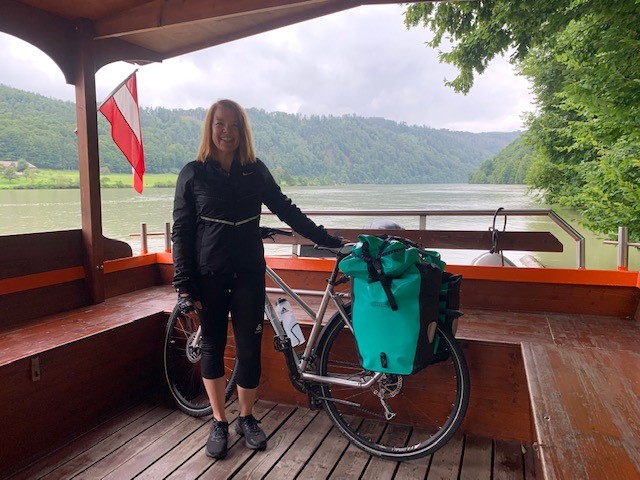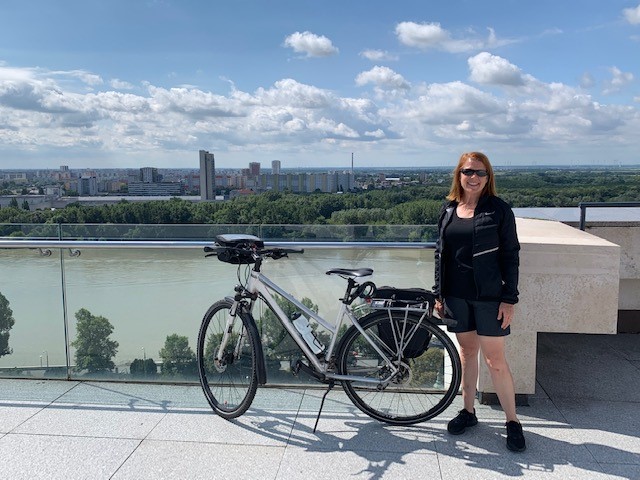Danube Cycle Plans - INTERVIEW WITH JILL WARREN (EUROPEAN CYCLISTS’ FEDERATION)
29-11-2021
With Jill Warren, CEO of the European Cyclists’ Federation, we have talked about her passion for cycling, EuroVelo routes, cycling tourism, investments in cycling and much more.
Two Danube Transnational Programme projects, the SABRINA and Danube Cycle Plans project (a few words about both projects are below), dealing with cycling have joined forces and prepared a series of interviews with people working in the mobility and transport field, with the focus on cycling. We have asked them about their opinion on different topics connected to more cycling, safer cycling infrastructure, promotion of cycling, etc. Visit the webpages of both projects to read the interviews which will be joined also in the capitalization newsletter published in December 2021 (subscribe HERE).
______________________________________________________________________________________________________________________________
 Jill Warren is the Chief Executive Officer (CEO) of the European Cyclists’ Federation (ECF). ECF is a Brussels-based non-governmental organization that promotes cycling as a sustainable and healthy means of transport and leisure.
Jill Warren is the Chief Executive Officer (CEO) of the European Cyclists’ Federation (ECF). ECF is a Brussels-based non-governmental organization that promotes cycling as a sustainable and healthy means of transport and leisure.
Prior to joining ECF, Jill spent over 20 years in senior roles at major international law firms. She has also worked in the automotive, pharmaceutical, and publishing industries. The US and Dutch national, Jill grew up near Chicago and has lived and worked in Europe for over 30 years, including in Germany, the UK and Belgium. She holds an MBA from Solvay Business School, Université Libre de Bruxelles.
Her strong passion for cycling attracted her to ECF. She is an avid everyday and recreational cyclist who loves to explore the world on cycling holidays.
______________________________________________________________________________________________________________________________
Jill, you have a great passion for cycling: not only advocating for more cycling but also practicing it as a mode of transport and leisure. Where are the roots of this passion?
As a child, my bicycle was my ticket to freedom. It took me everywhere I wanted to go. When I moved to Europe as a young adult, I found that using a bicycle to get around was often faster and more efficient than using a car. For many years I lived in Freiburg, Germany, which is a really great region for cycling. I graduated from day trips in the Black Forest, Kaiserstuhl and Alsace to multi-day cycling holidays in other parts of Europe. The best way to spend a holiday!
 There are a lot of efforts to transform the cities into cycling-friendly environments. Especially, with Covid-19, we have witnessed massive changes in favour of cycling in Paris, Rome and some other places. You have lived in many places around the world. How can you compare the quality of living in the places with a lot of cycling to the ones where people don’t bike? What are the advantages of cycling compared to other forms of transport? Why should countries/cities invest in it?
There are a lot of efforts to transform the cities into cycling-friendly environments. Especially, with Covid-19, we have witnessed massive changes in favour of cycling in Paris, Rome and some other places. You have lived in many places around the world. How can you compare the quality of living in the places with a lot of cycling to the ones where people don’t bike? What are the advantages of cycling compared to other forms of transport? Why should countries/cities invest in it?
There is something very special about cities that have a lot of great cycling infrastructure. You see many people of all ages and abilities out cycling. Children have more freedom to move around, and parents are less worried about their safety. Cycling cities are more vibrant and less choked up with car traffic. And their residents are healthier and happier. There are so many good reasons for cities to invest in cycling that translate into a better quality of life for all residents, whether they cycle or not. Can you think of a city that has made such a transformation in favour of cycling that regretted it and wants to go back to car dominance? I can’t!
One of the well-known ECF projects is the European cycle route network or shorter EuroVelo (EV). The safety of long-distance EuroVelo routes crossing 8 countries from the Danube area is one of the main focuses of the SABRINA project. On social media, we could follow your recent adventures on EuroVelo 8 in Barcelona (Spain), EuroVelo 5 and 15 in Alsace (France), you also cycled from Bratislava (Slovakia) to Vienna (Austria) following EuroVelo 6. How would you evaluate the infrastructure and its safety on those routes?
I personally feel safest and most comfortable riding on a wide, smoothly asphalted or very well packed gravel cycle path, with clear and frequent signage so that I know exactly where I’m going, especially if I am on a fully loaded bike on a long-distance trip.
The EuroVelo 6 in Austria is an excellent example of good, safe infrastructure and is a real joy to cycle on. I also enjoy the EuroVelo 5 and 15 in Alsace, which I began exploring years ago on day trips when I lived on the other side of the Rhine in Freiburg. It has also been great to see the recent developments and new signage along the EuroVelo 8 near Barcelona. Another favourite of mine is the EuroVelo 12 along the Dutch coast. And there are still so many other great routes to explore!
Have you had any bad experiences with poor/unsafe infrastructure while cycling and what was it? Where is room for improvement?
I was once on a long-distance cycle trip where there were many stretches of loose-gravel cycle paths. Although these paths were separated from car traffic, they were slow and rather uncomfortable to cycle on, especially when trying to cycle 80-100 km a day with a fully loaded bike, and the paths were even worse in the pouring rain. And this was a heavily marketed, very popular long-distance cycle route probably used by millions every year. I had expected a much better-developed cycling infrastructure than what I found, so there was lots of room for improvement in my view. The consequence of that experience is that I won’t be taking another cycling holiday on that route or recommending it to my friends, whereas I have gone back multiple times and taken friends with me on the cycle routes with the great infrastructure that I really like. High-quality, pleasant cycling infrastructure brings people back and results in rave reviews to their friends. That’s what we should ideally be striving for, isn’t it?
Many times we can hear that people not cycling point out the main reason is inadequate infrastructure. Would you agree that well-planned, built, maintained and especially safe infrastructure is pre-condition for more cycling and fewer fatalities as well as serious injuries amongst cyclists?
I would certainly agree that well-planned, built, maintained and especially safe infrastructure is extremely important for enabling more and safer cycling, with fewer fatalities and serious injuries for cyclists. The lack of safe cycling infrastructure is cited time and again as a key deterrent to more people taking up cycling or cycling more often.
Besides the EuroVelo cycle network, there are also a lot of national cycling networks. Some European countries are more, some less successful in this respect. One of the goals of the Danube Cycle Plans project is a new or revised national cycling strategy in 9 countries from the Danube region. In your opinion, why are the national cycling strategies so important?
National cycling strategies, if systematically implemented, can lead to favourable policies and major investments in cycling infrastructure as well as other measures to enable more cycling and achieve a lasting modal shift. At ECF we track and analyse national cycling strategies to try to understand which approaches and elements work best. There is no one-size-fits-all solution, but clear targets, backed up by policies and systematic, consequential investments and continuous improvements, are key.
EuroVelo long-distance routes, as well as national cycle networks, play a significant role also in the tourism sector. Cycling tourism is getting more and more popular. Can you share any statistical data about the popularity of EuroVelo routes?
Concerning statistics on the popularity of EuroVelo routes, based on the EuroVelo web statistics for the first half of this year, the top five most ″visited″ routes on the site were EuroVelo 15 - Rhine Cycle Route, EuroVelo 6 - Atlantic-Black Sea Route, EuroVelo 19 - Meuse Cycle Route, EuroVelo 8 - Mediterranean Route and EuroVelo 1 - Atlantic Coast Route. Overall, the site has seen a further strong increase in the number of sessions and visitors, which is a clear indicator of popularity and interest in these (and other) EuroVelo routes.
Through our collaboration with Eco-Counter, we have some statistics on the use of the EuroVelo route, which show that despite COVID restrictions being in place in many locations in Europe, there was a growth of cycle traffic on the EuroVelo routes during the first eight months of 2021 (compared to the same period in 2019). We observed a general growth of 2% on the EuroVelo Network, including a 12% increase at weekends, suggesting that much of this growth can be connected to tourism and leisure use (details available HERE). Furthermore, national datasets showed that leisure cycling grew last year in Germany, the Netherlands and France, proving that cycle touring is seen as a safe and attractive option for many Europeans.


What are the benefits of cycling tourism? The famous Danube Cycle Route follows the mighty Danube River from Germany to Romania but the opportunities for cycling tourism in the countries along the route are very different, especially because of (under)developed infrastructure. How can these gaps be reduced?
Cycling tourism has many benefits. It helps combat the over-tourism of certain hotspots by taking people off the beaten path and spreading tourism around to less-visited areas. It benefits small and medium-sized businesses, and the infrastructure also benefits local residents and improves rural connectivity. Cycling tourism contributes an estimated €44bn to the European economy every year – more than the cruise ship sector.
At ECF we have seen that transnational route development projects can help to fill the gaps, stimulate further investment and improve the infrastructure and opportunities for cycling tourism along a long-distance route that passes through many countries. Beyond such projects, centrally coordinated long-term management agreements such as those in place between ECF and partners for several EuroVelo routes are also beneficial for keeping up the momentum, promoting and marketing the routes as coherent cycling tourism products and maintaining and continuously improving standards that meet cyclists‘ needs and expectations.
The European Union invested from its various funds around 80 billion EUR in transport projects over 7-year funding periods. According to ECF data, in the 2007-2013 financial perspective approximately 700 million EUR went into cycling projects. This number grew to about 2-2.5 billion EUR in the past 7 years. Great achievement. However, the ECF considers a fair share for cycling would be at least 6 billion EUR in order to achieve an effective modal shift. What is your opinion needs to change for this goal to be achieved?
Not only did we see more EU Structural funds invested in cycling measured in the last funding period, more recently we have also been seeing a greater awareness at the EU level that cycling is a good investment. This was reflected for example in the guidance given to EU member states about the kinds of investments they should consider including in their National Recovery and Resilience Plans. Already €1.7bn has been earmarked for cycling projects in these plans, including for long-distance cycling routes that will be beneficial for cycling tourism. The European Commission’s Sustainable and Smart Mobility Strategy published last December also called for investments in cycling infrastructure to double. For our part, ECF published 27 country-specific guides to help stakeholders interested in unlocking EU funds for cycling projects to navigate the EU Structural Funds (see Unlocking cycle investments from EU Structural Funds - ECF Guide). Despite this, we know that €6 billion will not be near enough to engineer the kind of lasting change we want to see. For that to happen, there needs to be much more investment at all levels – EU, regional, national and local – in high-quality cycling infrastructure and other enabling measures.
In May 2021, the Pan-European Master Plan for Cycling Promotion was adopted in Vienna. The overall goal is to double cycling in the Pan-European region and increase it in every country by 2030. What, in your opinion, are the most important steps on the way to reach this target?
Doubling cycling levels is not an easy target. Achieving it requires, first of all, the political will to truly prioritise cycling as a sustainable, healthy and essential part of the mobility mix. Then it requires clear strategies that guide the policies, major infrastructure and other investments and also financial and behavioural incentives that will effect lasting change in favour of more cycling.
What is your first association to the word bicycle?
Joy. Cycling has brought me so much joy in my life, and I hope many more people can experience this.
____________________________________________________________
Photo 1: Jill Warren (personal archive)
Photo 2: Jill with her bicycle (personal archive)
Photo 3: Jill on her bicycle trip on EuroVelo 6 in Austria (personal archive)
Photo 4: Jill on her bicycle trip on EuroVelo 6 in Slovakia (personal archive)
____________________________________________________________
A few words about both projects:
- SABRINA project focuses on road infrastructure safety for cyclists as one of the most vulnerable road users. It tackles cycling infrastructure safety issues on existing, planned, and missing cycling corridors crossing nine countries in the Danube region. The main goal is to help decision-makers plan, design, and implement safe and sustainable solutions for improved cycling infrastructure in the region. More at the project’s webpage, Twitter or Facebook account.
- Danube Cycle Plans project aims to implement Pan-European Master Plan for Cycling Promotion. Project activities include the development of National Cycling Plans based on a common transnational Danube Cycling Strategy, defining a Danube cycle route network, infrastructure standards and adequate financial support and increasing the awareness of relevant stakeholders for the needs of cyclists. More at the project’s webpage.
